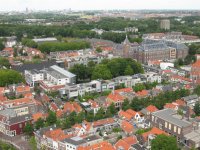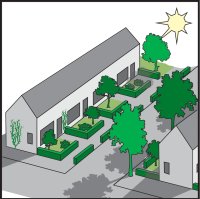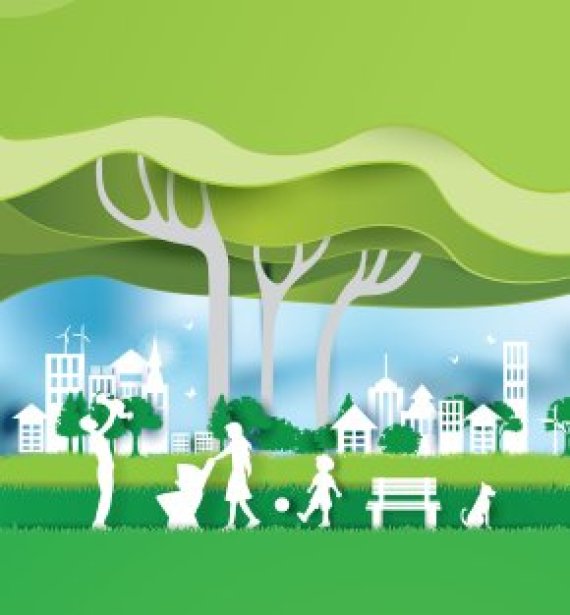TextRoelof Kleis illustration iStock/Shutterstock photos Wiebke Klemm
A warm summer’s day cheers everyone up. Ah, the sun! Lovely. Until warmth turns into heat and starts to become unpleasant. Then every strip of shade is precious. Cities can get especially torrid. The hot, dry summer in the Netherlands this year is still fresh in our memories. Well, get used to it. Thanks to climate change, that sort of summer is going to be quite common.
Microclimates
Vegetation can help to keep life bearable, though. Trees provide shade, so the more trees, the more shade. At least, that is the case if you do it properly, is the message from Wiebke Klemm, a recent PhD graduate in Landscape Architecture. Her thesis, entitled Clever and Cool, describes her study of how people experience microclimates in cities, and offers practical design guidelines based on her results.
The guidelines are an original move. Klemm: ‘many research papers in the field of urban meteorology end with a conclusion and the comment that the knowledge gained could be applied in design practices. I went a step further and translated my findings into practice by drawing up and testing design guidelines. It was important to me to do that.’

Thermal comfort
A central concept in Klemm’s research is thermal comfort. ‘A thermally comfortable or heat-proof city is one in which it is pleasant for people to be outdoors all year round,’ is her definition. ‘So it’s a city in which you don’t suffer as a result of conditions such as excess heat or radiation, but can enjoy the positive sides of them.’ The original meaning of thermal comfort is a pleasant temperature. ‘The term comes from interior design, originally: how people experience the thermal conditions in a room. So it’s about objective parameters such as air temperature, solar radiation, heat radiating off surfaces, atmospheric humidity and wind. But there is a subjective, psychological side to how we experience temperature, too. How you experience temperature depends on things like your age, your clothing, your activities and your preferences.’
Up to now, scientific studies have mainly looked at the effect of vegetation on heat in objective terms, says Klemm. ‘Only in recent years has that subjective side been looked at too. How do we feel about heat, and how do we deal with it? This is interesting information for a landscape architect. We want to design cities that do justice to the human dimension and enable people to enjoy the space and use it in their own ways. We want the space to meet their requirements.’
Park visitors
One of the research methods Klemm used was observation. With the help of students, she obtained a detailed picture of the behaviour of park visitors in Wageningen and Utrecht (see inset). Where do visitors go and sit or lie down on hot summer days? How is the park used at different times of day and days of the week? Klemm had a stroke of luck: there was a heat wave during her fieldwork period in July and August 2013. ‘A gift, because it meant I could show what happens on extremely hot days, which will be more common in future, with global warming.’
The study revealed, for instance, that the tipping point from pleasant warmth to uncomfortable heat lies at around 26 degrees Celsius. Above that temperature, people start opting for shade rather than sun. Not really breaking news, agrees Klemm. ‘There is a lot in this thesis about general beliefs, things we all actually pretty much know or guess to be true. The science of the obvious, you might say. We all know that vegetation provides cooling. But I wanted to quantify these things in my thesis.’

If there is freedom of choice, you are already well on the way to a heat-proof space.
Landscape architect Wiebke Klemm
Freedom of choice
Klemm distilled a rule of thumb from all the spying on park users. An ideal park should have 40 per cent full sun, 40 per cent full shade and 20 percent partial shade. These ratios best cater for the preferences of park uses. But she makes clear this is only a rule of thumb. ‘It’s about generating options. I think freedom of choice is very important. If there are several options, you are already well on the way to a heat-proof space. You need to realize that shade is most important in the hottest hours of the day. So make sure the shade from trees and buildings falls where people want to sit between 12 and 3 in the afternoon.’
Klemm used her findings to formulate nine design guidelines for street vegetation, parks and green spaces in cities as a whole. Smart planting of vegetation and the creation of a variety of microclimates is the common theme running through them. The guidelines are illustrated with photos and stylized drawings. As an example: plant trees with large crowns on streets with a lot of direct sunlight. Behind this simple guideline lies the fact that 10 per cent more trees on a street lower the radiation temperature by one degree. Radiation temperature is one of the most important factors determining thermal comfort, says Klemm. ‘Shade reduces the amount of direct solar radiation. And the paved area around a tree doesn’t heat up as much, so less heat bounces off it.’
Wiebke Klemm illustrated her guidelines on urban vegetation with drawings and photos such as these, showing street vegetation of different heights. This improves pedestrians’ subjective experience of the temperature.

illustration Adrie van ’t Veer
Varying heights
Another of the guidelines suggests that street vegetation should be of varying heights. This is because streets with varied vegetation in front gardens and small trees along the street are experienced as thermally more comfortable than streets with only big trees. Klemm: ‘Certain aspects of the aesthetic experience of vegetation apparently influence the subjective perception of temperatures. In a street with tall trees and nothing else, you do not actually see any greenery. Not that this is an argument for replacing tall trees with smaller ones. But it does increase our understanding of how it works. Even smaller trees have an effect, although they provide less shade and therefore contribute less to lowering the radiation temperature.’
Nor do Klemm’s guidelines imply that hitherto, town planners and landscape architects have just made things up as they went along. ‘Before landscape architects create a design, they always start by analysing the situation. They collect data about things like the soil, the water situation, traffic and how the area is used. I argue that we should add the microclimate to all those aspects. That means analysing the sunlight, the shade and people’s behaviour, and giving thought to how you can facilitate or steer that behaviour with your design. Thermal comfort is not an end in itself, but it should be taken into account. I am all for integration. A design geared to thermal comfort should offer the benefit of keeping people cool, but it must also be pleasant and attractive to live in. People should enjoy being out of doors and making use of outdoor spaces.’
The Wilhelminapark in Utrecht on a summer’s day.
The Wilhelminapark and the Torckpark
Wageningen’s small Torckpark and Utrecht’s much bigger Wilhelminapark are visually quite different. But in terms of the proportion of space devoted to trees, grass, and water, they are similar. For 12 days in July and August 2013, Klemm got students to take a fixed route through the parks at the same time of day. On a map they recorded precisely where people were sitting or lying. That provided a detailed picture of the use of the park. Interestingly, the hotter it got, the less the park was used. Klemm does not have a satisfactory explanation for that. Comparable research in Hungary showed the opposite. ‘But that was on a campus with a lot of young people, who are often less bothered by heat. And there was a heat wave during my study. In that situation, whether you go outside depends partly on where you live. It might be cooler at home than in the park or on the way there.
Climate adaptation agreement
The Netherlands intends to get serious about adapting to climate change. The national government, provinces, municipalities and water boards signed an agreement two weeks ago to invest 600 million euros over the coming years in climate-proofing both the cities and the countryside. The emphasis lies on coping with flooding and drought. But making cities heat-proof is mentioned explicitly in the agreement as well.

